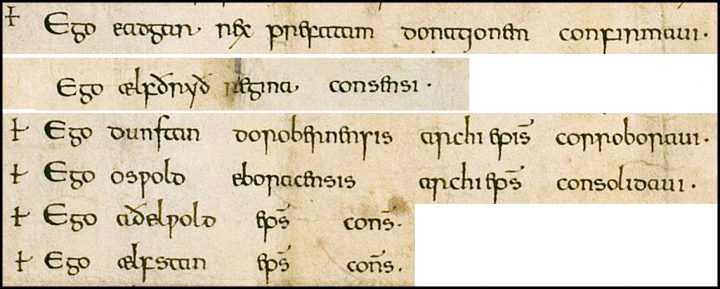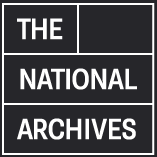
Anglo-Saxons – Gift from a King
Suitable for: Key stage 2, Key stage 4
Time period: Medieval 974-1485
Curriculum topics: Anglo-Saxons, Changing power of monarchs
Suggested inquiry questions: What can we learn about Anglo-Saxon rule from this grant from the king?
Potential activities: Answer questions, create your own charters granting areas of the classroom
Download: Lesson pack
King Edgar came to the throne of Wessex at the age of sixteen in 959 after his elder brother, Eadwig, died. He carried on the peaceful rule of his ancestors and is believed to be King of England ruling over the other kings of the Anglo-Saxon Kingdoms, with the Kings of Scotland and Cumbria pledging allegiance at his coronation. He recalled the influential Bishop Dunstan (later St Dunstan) from exile who would go on to become Archbishop of Canterbury under Edgar’s reign. Dunstan, Oswald and Ethelwald, bishops of Worcester and Winchester, were very powerful as the heads of the Church, even shaping some of Edgar’s policies.
Despite ruling so long ago, Edgar’s reign is still visible in our lives today. It was during Edgar’s rule that England was divided into shires and hundreds for local governance. His coronation is the earliest to be described in detail and has formed the template for all coronations of English Royalty to this day.
Use this lesson to find out more about living in Anglo Saxon England through one of the oldest documents looked after by The National Archives.
Tasks
Anglo-Saxon Charter S795
What’s in a charter?
The structure of the charter can be explored in several ways.
- Students could be given the highlighted charter and asked to assign the correct labels from the mixed list within.
- Students could be given one section of the charter and asked to present on its purpose. This could be a short paragraph, a discussion and feedback to the class, or a more creative output such as a poster.
- Students could consider why the charter is laid out in this order and whether changing the order of the sections has any effect on the meaning or purpose of the document.
- As this is a formal structure repeated in most charters of this type, students could consider why a formal structure is useful for grants of land and how the document would have been used at the time of its creation.
- Students could attempt to write their own charter following this structure, granting a classroom table to a group of students or the seat next to them to their friend.
The first line says: “Our Lord Jesus Christ reigneth for ever.”
- Why does a document about a gift of land start with a statement about Jesus Christ?
- The words ‘Our Lord Jesus Christ’ have been shortened from ‘domino nostro Jhesu Christo’ to ‘dno nro ihu xpo’. Why would the Anglo Saxons use shortened words for this phrase? (Hint: how often are they used?)
- Crosses are used to open key sections of the writing. What could the symbol mean? What does it represent? Why is it included in the document?
This section says: ‘free of all secular tribute and royal service, excepting only going to the wars and the building of bridges or castles.’
(Secular = non-religious. Royal service = duties to the king. )
- What does it mean for this land to be ‘free from royal service’?
- What can Edgar still do with the land?
This section of the Charter is written in Old English instead of Latin like the rest of the document. It lists the places that are covered in the gift so that everyone knows which area of land is being gifted. Why would this part be in a different language that the rest of the charter? What does it tell us about the people who lived in the area and the people who ruled the land?
Can you find these placenames in the document?
- Nymed
- Copelanstan (hint: copelanſtan)
- Sedgbrook (hint: Secgbroc)
- Shipbrook (hint: ſcipbroc)
The section says:
“This is the land described as the three hydes at Nymed: First, to Copelanstan ; from that stone westwards on to the high road at Eisandune; then from there westward to the high road at Red Flood ; from there to Sedgbrook’s head ; from there down Sedgbrook to where the stream strikes west; from there out on Heathfield to the ditch-head; from the ditch down on Hane; from there down along the stream to where Kushbrook strikes on Nymed ; from there eastward on Eushbrook to Shipbrook ; then up Shipbrook, and so back to Copelanstan.”
This stone pillar is what remains of the ‘Copplestone Cross’, a stone that has been standing in this spot since the Anglo Saxon period.
- Can you find where it is mentioned in the charter?
- What other boundary markers can you find?
Teachers' notes
This lesson provides pupils with a glimpse of Anglo-Saxon society through one of the oldest documents looked after by The National Archives. The document is not part of our standard collection of royal and governmental documents preserved for administrative purposes, but was instead presented to us for safekeeping in 1868.
This document is a charter, a formal statement of grant, making the recipient Ælfhere thane of a small area of what is now Devon. A thane is described as a man who held land granted by the king or by a military nobleman, ranking between an ordinary freeman and a hereditary noble. Ælfhere was given three hides of land, a measurement of potential income rather than area, showing a fairly sizeable gift for the minister’s loyalty.
Pupils can examine the content of the charter to recognise the influence of the King and the Church over the land and its people. Pupils could research Anglo-Saxon life to discover what the land could be used for, in terms of farming and woodland crafts. Pupils can consider the rights of the King to use land he has granted to others for his own purposes as described in the Charter, and why this would be necessary during the Anglo-Saxon period.
They can also research key figures mentioned within this charter, including King Edgar, Dunstan Archbishop of Canterbury and Oswold Archbishop of York. Dunstan’s influence on the church and royal ceremony, for example, is still recognisable in practices such as the coronation today. Edgar’s second wife, Ælfthrythe, mentioned in this charter, is also a key figure in history with several dramatic deaths surrounding her marriage and her sons. Her influence as an Anglo-Saxon Queen (the first to receive her own coronation) secured the reign of her son Elthered ‘the Unready’.
An Anglo Saxon charter has different purposes, usually either a ‘diploma’ granting land or powers, or a ‘writ’ providing instructions to be carried out. Occasionally charters could also act as wills, gifting land on the event of the writer’s death.
This charter falls into the category of diploma, and follows a fairly standard structure.
Sources
The main source used in this lesson is PRO 30/26/11 – A charter from King Edgar granting land to his Thane Ælfhere. It is recorded in the Sawyer Catalogue – a list of all known Anglo Saxon charters – as S795.
The charter was presented to The National Archives by H. Garling, esq., in November 1868.
Connections to Curriculum
Key Stage 2
Britain’s settlement by Anglo-Saxons and Scots: Anglo-Saxon invasions, settlements and kingdoms: place names and village life; Anglo-Saxon art and culture, Anglo-Saxon laws and justice; Significant People: King Edgar
Key Stage 4
AQA GCSE History
Britain: Migration, empires and the people: c790 to the present day: including invasion: Vikings and Anglo-Saxons
External links
Find out more about King Edgar
https://www.englishmonarchs.co.uk/saxon_12.htm
Back to topSuitable for: Key stage 2, Key stage 4
Time period: Medieval 974-1485
Curriculum topics: Anglo-Saxons, Changing power of monarchs
Suggested inquiry questions: What can we learn about Anglo-Saxon rule from this grant from the king?
Potential activities: Answer questions, create your own charters granting areas of the classroom
Download: Lesson pack







 The National Archives
The National Archives






